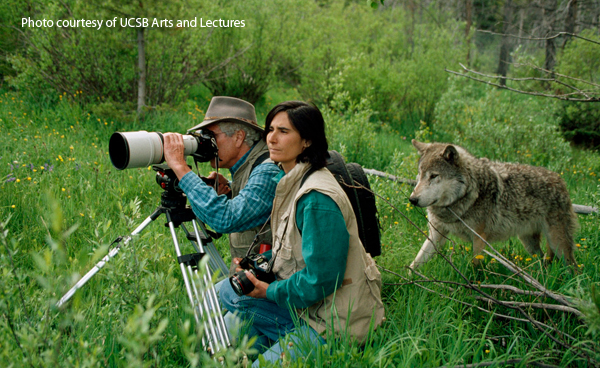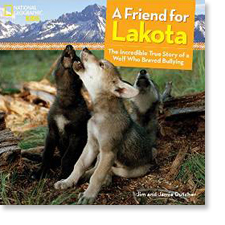A recent book for young readers and a presentation by the authors for 3rd and 4th grade children reminded me how much damage stereotypes and misinformation can create. In this case, Jim and Jamie Dutcher have spent their professional lives as filmmakers and writers documenting the real lives of wolves in an effort to correct the erroneous and ultimately destructive misconceptions about these magnificent and important creatures.

The Dutcher’s book for adults, The Hidden Lives of Wolves (National Geographic), is a stunning look at the results of living in Idaho’s Sawtooth Mountains. And just this year, this husband and wife team wrote a book for younger readers focusing on this wolf pack.

Like the children who attended their presentation, I had the opportunity to ask questions of the authors. Here are some of my questions and the Dutcher’s response:
What made you decide to adapt this story for younger readers?
When we were asked by NGS [National Geographic Society] to write a children’s book, we knew that it was the story of Lakota and Matsi that we had to tell. When found that when we would do our presentations, afterwards children would come up to us and want to know more about Lakota. Was he loved, did the other wolves care about him, did he matter. When we tell the children that Lakota really did matter and that he was a very important member of the family and that he had a friend, Matsi, you can see that they have been bullied. When we explain that Matsi looked after Lakota and protected him and after a time, the bullying stopped. The children then walk away a little taller.
The observations we made of Lakota and Matsi always made us feel that this was more then a story of wolves, but a story of human nature as well. We have always said that you can learn a lot by watching wolves; their lives are truly reflections of our own.
The photographs in Lakota are very natural and really stunning. How did you take them? How did you choose which of what must have been many more to include in this book?
It is very difficult to observe and photograph wolves in the wild. If you are lucky enough to see a wolf, it will stop what it is doing, look, and move away. Biologists have done behavior and social studies/observations on wolves in enclosures of fewer than five acres. We had the largest enclosure of its kind in the world, 25 acres. Built on the edge of wilderness it offered a wonderful mixture of sub-alpine terrain. We had a small, tented camp within its territory. This allowed the wolves the space to be wolves.
We had to hand-rear and bottle feed pups, from the moment they opened their eyes so they would trust us completely and regard us without fear. Though the pups were bottle fed, they were never treated as pets. We couldn’t ask them to do anything, you could never put a leash on one, and they didn’t know their names. But we were however, able to bring out our film gear and observe them without stopping or altering their behavior. We let the wolves approach is if they wanted to; if they chose to ignore us, we didn’t pursue. Everything was on their terms.
What characteristics are shared by both wolves and humans? What can wolves teach people or maybe, what should people learn from wolves?
Wolves are compassionate and deeply caring family animals. They care for their injured. They look after one another. They work/hunt through cooperation. They are joyful and fun loving. But most importantly, they know how to “forgive.” And that is probably the most important thing we can learn from them.
Talk about why wolves are so crucial in our ecosystem.
Wolves are not only social animals, living together as families, they are also a keystone species, in that they help to manage and bring stability to ecosystems.
In the 1920’s, wolves were nearly completely eradicated from the American West, and then realizing that wolves were nearly extinct in this area an that the ecosystems were becoming terribly out of balance, the U.S. government captured wolves in Canada and reintroduced them to Yellowstone National Park and Central Idaho in the mid-1990’s.
Since the reintroduction there have been many improvements to the ecosystem of Yellowstone and other areas, but Yellowstone is where various scientific studies have been done.
For example, while wolves were absent for those 70 years or so, elk — having few predators preying on them — would linger in the riparian areas, along the rivers and streams, browsing on and suppressing new growth of willow, aspen, and cottonwood trees.
Today, the fear of wolves has redistributed the elk. They are now much more alert and prefer higher ground where they feel safe and can observe wolves from a long distance.
Meanwhile, since the elk have moved on, the vegetation along the rivers and streams has bounced back. Until recently, because the elk would eat all the young saplings, the only cottonwood trees in the entire park were no younger then 70 years of age. Trees now stabilize the banks of streams and provide shade, which lowers the water temperature and making the habitat better for trout, resulting in more and bigger fish!
The remains of a kill, left behind by the wolves, provides critically needed food for other animals like grizzly bears, black bears, wolverines, bald eagles, and golden eagles, just to name a few.
In Yellowstone, the over-population of coyotes has fallen by half; the wolves have either killed them or chased them away. This has increased the number of rodents, rabbits, hares, pocket gophers and field mice; animals that provide food for struggling birds of prey — owls, hawks, and eagles — are now doing much better.
The drop in the coyote population, because of wolves, has also benefited pronghorn antelope. Coyote specialize in preying on young newborn pronghorn fawns and their mothers as they try to protect their offspring. Wolves don’t. In fact, pronghorn will seek out areas where wolves are raise their fawns and protect them from coyotes.
On top of all these ecological benefits, having wolves back in Yellowstone draws 150,000 new visitors each year, people that are coming to the park just to see wolves, that’s an extra 35 million dollars added annually to the local community.
Tell us how you lived while camping in the mountains.
Wolf camp was a forever-evolving project, and our resources were very limited. Our main tent was a Mongolian Yurt, which is round and has a conical shaped roof. This allows for the weight of a lot of snow. The Yurt is where we would work on our gear, discuss the observations of the day and cook and eat our meals. Our other tent, where we slept was a large “wall tent” this is where we kept our camera and sound gear. The Yurt was on an elevated platform, about 12 feet off the ground and the wall tent was below. Our tents were surrounded by chain link, not to protect us from the wolves, but to protect our “stuff!” The wolves would take any opportunity they could to steal anything they might be able to get hold of and make it their “toy” for the day!
Heat came from a wood stove, our shower water came from a near by creek or from melted snow, our light and cooking flame from candles, oil and propane.
Would you do this again?
We have been asked may times if we would do the project again. The political climate is such that we would never be able to get the permits again nor to “fly under the radar” of the very vocal anti-wolf community that has sprung up. That said, it was an experience and project that can never happen again and we are quite humbled to have experienced it. If the climate was right, we don’t think that we would do it again. The wolves of the Sawtooth Pack gave us so very much, that it is our time to give back to them.
Tell us about how you’ve expanded your work with Living with Wolves.
As mentioned in the above, the wolves gave us so much personally, that we needed to give back to them. Wolves are still so misunderstood with people believing in the myth and misconception of wolves rather then the true nature of wolves. We have set down our camera gear and started a non-profit called, Living with Wolves . Living with Wolves is dedicated to raising broad public awareness of the truth of wolves, their social nature, their importance to healthy ecosystems, and the threats to their survival. We build acceptance that can lead to coexistence between people and wolves sharing the same land.
About the Author
Reading Rockets’ children’s literature expert, Maria Salvadore, brings you into her world as she explores the best ways to use kids’ books both inside — and outside — of the classroom.

